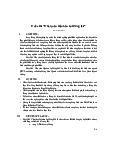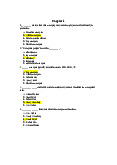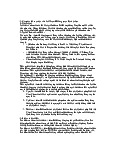



















Preview text:
HUMAN RESOURCE MANAGEMENT TOPIC
PAY FOR PERFORMANCE AND EMPLOYEE BENEFITS Subject :
Human Resources Management Class MH : HRM 203DE01 - 1200 Instructors :
Mrs. Đào Thị Ngọc Mai NO. ID NAME CONTRIBUTE 1 22118072 Lê Thị Thanh Ngọc 100% 2 22117851 Đinh Hồng Ngọc 100% 3 22002577 Châu Kỷ Phúc 100% 4 22122586 Đỗ Thị Ái Quỳnh 100% 5 22117816 Phạm Diễm Quỳnh 100% December 2022 JOB ASSIGNMENT SHEET NO. NAME Mission CONTRIBUTE 1 Châu Kỷ Phúc (leader) 4.1.1, 4.1.2 , 4.9 100% 2 Đinh Hồng Ngọc
Title page, introduction, 4.1.1, 4.1.2 ,4.4,100% 4.5,4.7, 4.8. 3 Lê Thị Thanh Ngọc
Làm báo cáo, ppt, hình ảnh, 4.1.1, 4.1.2 100% 4 Đỗ Thị Ái Quỳnh
Làm báo cáo, 4.1.1, 4.1.2, 4.2, 4.3, 4.6. 100% 5 Phạm Diễm Quỳnh 4.1.1, 4.1.2, 5 100% ABSTRACT
Pay-for-performance compensation can come in many varieties depending
on your organization’s budget, compensation philosophy, and organizational goals.
When designing a pay-for-performance plan, you’ll want to consider the outcomes
your organization is looking to achieve, the frequency with which you’ll reward
employees, and the total increase you’ll be budgeting to fund these programs. There
are two general categories of pay-for-performance compensation: merit pay
increases and variable pay programs. As you look to implement a pay-for-
performance program in your organization, you can use either of these two types of
pay-for-performance plans – or both – to incentivize employee performance and drive your desired outcomes.
THANK YOU TO THE LECTURER
Report on Human Resource Management made by group 7. Member from
Faculty of Finance and Banking, Hoa Sen University in October 2022.
Thank you for a wonderful semester. I appreciated your caring disposition
and teaching style. As a sophomore, I had the opportunity to learn from excellent
and dedicated instructors. Thank you for incorporating humor and even
performances. Thank you for leading our discussion section. This class was
challenging at times but there was value in being exposed to the material. Thank
you for your efforts in grading communication and individual feedback. Thanks a lot! TEACHER’S COMMENTS
.................................................................................................................................
.................................................................................................................................
.................................................................................................................................
.................................................................................................................................
.................................................................................................................................
.................................................................................................................................
.................................................................................................................................
.................................................................................................................................
.................................................................................................................................
.................................................................................................................................
.................................................................................................................................
.................................................................................................................................
.................................................................................................................................
.................................................................................................................................
.................................................................................................................................
.................................................................................................................................
.................................................................................................................................
.................................................................................................................................
.................................................................................................................................
................................................................................................................................. TABLE OF CONTENTS
TEACHER’S COMMENTS......................................................................................................................................5
INTRODUCTION......................................................................................................................................................7
4.1 CASE STUDY.......................................................................................................................................................8
4.1.1 Case summary....................................................................................................................................................8
11-22. Is there another incentive plan you think would work better for the pressers? Describe it..........................8
1. Individual Employee Incentive Plans.................................................................................................................14
3. Hybrid Incentive Plans........................................................................................................................................15
6. References.............................................................................................................................................................22 INTRODUCTION
There are many methods of calculating salary for employees in the world. In
particular, the 3P salary system is considered to be the most fully developed and
widely applied. The 3P salary system is a salary payment method applied in modern
enterprises, aiming to create a salary suitable to the working capacity of employees.
In which, the amount of salary that the employee receives in the month will be
equal to the sum of the individual factors. The 3 factors are: Salary Job Location,
Personal salary, Performance salary.
By paying salaries according to individual performance, businesses can also exploit
the capacity of employees. If in the past, employees often thought that they only
needed to ensure the ability to fully complete the assigned work, then with the
policy of paying more for good people and effective workers, employees will
automatically have goals. goals and motivation at work.
At the same time, by evaluating performance on the basis of common
achievements, enterprises have created a connection between individuals and the
collective results, thereby easily building and implementing a common development strategy. 4. MAIN CONTENTS 4.1 CASE STUDY 4.1.1 Case summary Carter Cleaning Company
Jack Carter has questioned himself whether hour payment is a good idea. His basic
policy has been to pay employees an hourly wage, except that his managers do
receive an end-of-year bonus depending, as Jack puts it, “on whether their stores do well or not that year.”
Initially the employee could drop 12 to 15 pieces when he got paid 8$/h. When the
change is deployed, he progresses 25 to 35 pieces per hour and earns 0.33$ per item
he cleans. On the whole, the experiment worked well. The sales and employee's
work efficiency increase as payment methods shift from hourly wage to performance payment.
However, The quality of Walt’s work has dipped a bit, plus his manager has to
spend a minute or two each hour counting the number of pieces Walt pressed that hour Questions
11-20. Should this plan be extended to pressers in the other stores?
11-21. Should other employees (cleaner/spotters, counter people) be put on a
similar plan? Why or why not? If so, how, exactly?
11-22. Is there another incentive plan you think would work better for the pressers? Describe it.
11-23. A store manager’s job is to keep total wages to no more than 30% of sales
and to maintain the fuel bill and the supply bill at about 9% of sales each.
Managers can also directly affect sales by ensuring courteous customer service and
by ensuring that the work is done properly. What suggestions would you make to
Jennifer and her father for an incentive plan for store managers? 4.1.2 Case solutions
11-20. Should this plan be extended to pressers in the other stores?
For me, I think this plan shouldn’t be extended to pressers in the other stores.
Because, Walt can generally press 25-30 pieces per hour, with the small increase in
pay, and he generally earns his target wage but the quality of Walt’s work has
dipped a bit, made his manager has to spend time counting how much pieces Walt pressed that hour.
11-21. Should other employees (cleaner/spotters, counter people) be put on a
similar plan? Why or why not? If so, how, exactly?
I think this plan only applies to a few positions in the company. There are many
reasons to apply this plan to employees and other stores because it will bring
benefits such as work efficiency, profit for the company. When these plans are
applied to the company, other employees will work diligently, with purpose, and
thus they will do better. However, they should make sure they wash their clothes
properly. As is the case with Walt, he can press more than 25 shirts per hour, but the
quality has dropped from before. That would be good for him for making a little
more money, but it would also greatly reduce customer satisfaction. In the long run,
the company's revenue will decrease. Instead of using a plan like Jack Carter, it
makes more sense to use a customer satisfaction method that makes more sense for
the company. This both motivates employees to work better and customers will also
feel more satisfied with the store's laundry service.
11-22. Is there another incentive plan you think would work better for the pressers? Describe it. Combination plans
This type of plan includes all variations of salary plus other monetary incentive
plans. The variations include base salary plus commission on all sales, salary plus
bonus. On sales over quota, salary plus commission plus bonus, and so on.
A combination plan design benefits your top performing employees. Your business
can leverage a combination plan to establish additional retirement allocation for top
performers & key employees. This allows for many variations of incentives that
help you find and retain top employment talent. Profit – sharing
A profit-sharing plan gives employees a share in their company’s profits based on
its quarterly or annual earnings.
It is up to the company to decide how much of its profits it wishes to share.
Contributions to a profit-sharing plan are made by the company only; employees cannot make them, too. Merit pay
Merit pay is the type of compensation a company uses to reward higher-performing
employees with ongoing additional pay. Merit pay is sometimes called incentive
pay or pay-for-performance, and it involves giving employees base pay increases or
bonuses based on their performance.
11-23. A store manager’s job is to keep total wages to no more than 30% of sales
and to maintain the fuel bill and the supply bill at about 9% of sales each. Managers
can also directly affect sales by ensuring courteous customer service and by
ensuring that the work is done properly. What suggestions would you make to
Jennifer and her father for an incentive plan for store managers?
Jennifer and her father should definitely consider implementing an incentive plan. I
think the Carter Cleaning Company should look into introducing bonuses of sorts
whether that be annual bonuses, monthly bonuses, etc. I think by introducing this it
would allow the employees to have something to work for and I think it would
increase the overall quality of their work and their work environment.
Payment differences according to type of clothes (merit pay)
bonus for the most efficient store(s)
Profit-sharing , gainsharing, performance plans, annual bonus
Allowing more free time when targets are met
4.2 What is an incentive plan?
Incentive plans are a type of employee compensation structure that uses certain
rewards to motivate team members to work harder and achieve specific goals.
This type of compensation goes beyond the paycheck and benefits that all
employees should receive for the hours they work.
Examples of incentive pay include: Cash, including commission, year-end
bonuses, sign-on bonuses, and performance bonuses. Shares or company stock options.
4.3 How do employee incentive plans work?
Incentive plans are a type of employee compensation structure that uses certain
rewards to motivate team members to work harder and achieve specific goals.
This type of compensation goes beyond the paycheck and benefits that all
employees should receive for the hours they work.
Business and organization leaders often will use incentive plans as a way to bolster
sales and keep employees motivated. The aim is to strategically leverage incentives
to drive specific outcomes and align employee actions with your organization’s goals.
To instill an employee incentive plan, you’re going to need your team members on
board, pick incentives they’ll actually work hard for, and make sure that everyone’s
on the same page regarding organizational objectives.
4.4 What are the benefits of employee incentive plans?
Here are how incentive plans benefit your company:
Increased employee motivation and productivity. With concrete targets,
employees can better focus on the tasks that support these efforts. And, with
incentives and prizes to motivate them, employees will work even harder to achieve those goals.
Increased employee retention rates. Fun prizes and rewards can create a
more engaging atmosphere for employees, motivating them to continue
adding value to your organization for the long run.
Set goals to guide overall progress. An incentive compensation plan can not
only keep your employees on track but also better align your overall
organizational progress with your specific strategic goals.
Here are how incentive plans benefit employees:
Fun rewards for meeting certain targets. Who wouldn’t love getting an
extra PTO day or a GrubHub gift card for accomplishing a task?
Healthy sense of competition and teamwork. By nature, incentive
compensation plans will motivate employees to work harder on their
individual tasks. But it can also inspire them to work together, especially if
your goals involve multiple roles collaborating.
Bigger investment in organization success. Because employees are
working towards specific goals and are being rewarded for them, they have a
bigger stake in your organization’s long-term success.
The benefits that you reap will likely depend on the type of plan you implement and
how successful it is. Usually, incentive plans are pretty flexible and can be adapted
to your unique organizational structure. However, they’ll likely fall into two
categories: Individual and Team-based incentive plans.
4.5 The Difference Between Individual vs Team-Based Incentive Plans
When creating an incentive compensation plan, organization leaders need to first
consider if their work environment better supports an individual or team-based
program. There are advantages and disadvantages to both.
Depending on the mix of industry and position types, certain organizations thrive
on one form of incentive over another. Let’s discuss the advantages and
disadvantages of both individual and team-based incentives. 1.
Individual Employee Incentive Plans
Individual employee incentive plans are compensation programs that focus on
targets and rewards for just one team member.
An advantage of an individual incentive program is the recognition it gives
individuals for their efforts. This type of recognition not only motivates the top
performer to keep up the good work up but also can motivate others.
By storytelling how top performers achieve their goals, other team members have
inspiration as to how they too can become stronger contributors.
However, individual incentives also have their fair share of problems. For starters,
an overly competitive environment can be created. Workers may even be pushed to
cross boundaries and make questionable ethical decisions to reach goals, which
definitely should not be encouraged by your compensation strategy. 2. T
eam-Based (Group) Incentive Plans
Team-based or group incentive plans are similar to individual ones except the
rewards are for groups of employees and are based on group or organizational performance.
An advantage to group incentives is positive peer pressure. One article mentions
that employees are often motivated by the fear of letting down their team members.
While each team member brings their own unique skillset and experience, these
differences also can balance a team and motivate everyone to do their best in their assigned roles.
In a best-case scenario, group incentives can empower employees to work
harmoniously. In the worst-case scenario, the exact opposite could happen.
For example, possible infighting with unmotivated or outright defiant employees
can result in a hostile work environment. Low-performing employees then feel
overwhelmed with pressure to perform at levels that they are not ready for. 3. Hybrid Incentive Plans
To curb the possible challenges from either individual or group incentive plans,
some leaders lean toward a hybrid plan. This type of plan includes an overall group
incentive as well as individual incentives for top performers.
This allows employees who individually go above and beyond to be rewarded
while simultaneously recognizing group efforts and values.
The hybrid approach also gives other employees an opportunity to gain some
recognition for their efforts for the whole collective. This lowers the chances of an
overly competitive environment developing. Careful monitoring and transparent
reporting also can ease possible negative competition and dishonesty in order to achieve goals.
Astrology® asked Michael Maciekowich, Astron Solutions’ National Director, for his
take on the difference between the two types of plans. Mike shares with us that:
The difference between individual and team-based incentives relates to defining the
outcomes and ensuring there is a clear ‘line of sight’ regarding controlling the achievement of those outcomes.
Individual incentives focus on each employee in his/her efforts to meet job-related
outcomes and/or special projects. Individual incentives tend to use goals that follow
the SMART acronym (Specific, Measurable, Achievable, Realistic, and Time-
Bound). Success in achieving team-based goals is dependent upon accurately
defining the team that will be included in the plan, such as a unit, department, or organization.
In this case, the focus is on defining outcomes that require collective efforts to
achieve. Rewards are often shared equally among the team members. The most
successful hybrid plans are those that are established as a team-based plan with
outcomes requiring collective efforts, and with the distribution of awards based on
individual performance in contributing to that collective effort.
4.6 Advantages and disadvantages of incentives ADVANTAGES
Healthy competition ( Bonus would lead to a more progressive and competitive
working environment . Employee incentives simply take advantage of the human desire to “win.”)
Clearly defined goals (It can improve the work-flow and work methods.)
employee retention( Incentive plans make employees hardworking and innovative.)
When employees are dedicated, supervision costs can be reduced. DISADVANTAGES
Quality of work may suffer ( For enhanced incentives, they may sacrifice quality.)
Inter-personnel relationships may suffer (Incentive plans can lead to disputes
among workers since some earn more than others.)
Over time, it can create a sense of entitlement, decreasing motivation and lowering performance
It eliminates productivity from low-level performers. (Employees with low
productivity will drop their performance and even lose their effort when they don’t get paid)
4.7 Best Practices For Managing Employee Incentive Plans
Now that you know the benefits and disadvantages of different types of incentive
plans, it’s time to put them into action! To better prepare, we’ve compiled a list of
our recommended best practices.
No matter the types of incentive plan that you decide to implement, here are some
essential tips that can keep your processes organized and set you on the path to success:
Invest in key technology to track and facilitate your incentive plan
program. One with metrics capabilities and effective reporting features is
key. Check out our dedicated guide to performance management software for more advice.
Keep track of key performance indicators (KPIs) and other metrics on a
continuous basis. This way, you can get a sense of how your incentive plan
is working in real-time. If you see that a certain task isn’t getting the
engagement you’d like, you can proactively take steps to address this.
Implement both individual and group progress reports. These reports can
serve as a tool for troubleshooting, allowing time to remove potential issues
before they become larger concerns. Having reports for both individual and
group progress also allows you to compensate team members fairly. You can
call out top performers as well as show appreciation for individuals who
might not display personal progress but are adding to overall organizational goals.
Adapt the incentive plan program to unforeseen circumstances. If
something happens to affect how you can compensate team members, like a
global pandemic, there’s nothing wrong with tweaking your existing
incentive plan to better reflect new budgets or other impacts. And, if
achieving the goals turns out to be unfeasible or unrealistic due to external
forces, adapting the plan to fit new circumstances is essential.
Communicate with employees and management concerning program
progress. If you see that your incentive plan is driving monumental value,
you should communicate this with your team. On the other hand, if the plan
is failing to drive the expected or intended results, you should maintain
transparency with this as well.
Sometimes, you need professional help to formulate the best incentive plan that
meets your employees’ unique needs and drives your organization towards core
goals. An HR consultant can work closely with your team to help you determine
those goals and outline a detailed action plan
4.8 Individual employee incentive and recognition programs
Several incentive plans are particularly suited for use with individual employees. Piecework plans
A system of pay based on the number of items processed by each individual worker
in a unit of time, such as items per hour or items per day.
Piecework is the oldest individual incentive plan and is still the most widely used.
Here, you pay the worker a sum (called piece rate) for each unit he or she produces.
Thus, if Tom the Web surfer gets $0.40 for each e-mail sales lead he finds for the
firm, he would make $40 for bringing in 100 a day and $80 for 200.
In a perfect world, developing a workable piece rate plan requires industrial
engineering (that’s how Frederick Taylor got his start). The crucial issue is the
production standard and industrial engineers usually set this in terms of a standard
number of e-mail leads per hour or a standard number of minutes per e-mail lead. In
Tom’s case a job evaluation indicated that his web surfing job was %8 an hour. The
industrial engineer determined that 20 good leads per hour was the standard
production rate. Therefore the piece rate (for each lead) was $8 divided by 20 or
$0.40 per sales lead. Of course we need to ensure that Tom makes at least the
minimum wage, so we’d probably pay him $5.85 per hour – the minimum wage in
July 2007 – whether or not he brings in 15 leads, and then pay him $0.40 per lead
for each over 15. In practice most employers set the piece rates more informally. Straight Piecework
An incentive plan in which a person is paid a sum for each item he or she makes or
sells, with strict proportionality between results and rewards.
Piecework generally implies straight piecework which entails a strict
proportionality between results and rewards regardless of output. However, some
piecework plans allow for sharing productivity gains between employer and worker
such that the worker receives extra income for some above normal production. So if
Tom starts bringing in 30 leads per hour instead of the standard 20 his piece rate for
leads above 25 might bump to $.45 each. Standard hour plan
A plan by which worker is paid a basic hourly rate but is paid an extra percentage of
his or her rate for production exceeding the standard per hour or per day Similar to
piecework payment but based on a percent premium
The standard hour plan is like the piece rate plan, with one difference. Instead of
getting a rate per piece the worker gets a premium equal to the percent by which his
or her performance exceeds the standard. So if Tom’s standard is 160 leads per day
(and thus $64 per day) and he brings in 20 leads, he’d get an extra 25% (40/160) or
$ 80 total for the day. Some firms find that expressing the incentive in percentages
reduces the workers tendency to link their production standard to pay (thus making
the standard easier to change) It also eliminates the need to re-compute piece rates
whenever hourly wage rates are changed. Pros and cons
Piecework plans have pros and cons. They are understandable, appear equitable in
principle, and can be powerful incentives, since rewards are proportionate to
performance. However, workers on piecework may resist attempts to revise
production standards, even if the change is justified. Indeed, these plans may
promote rigidity. Employees concentrate on output and are less willing to concern
themselves with meeting quality standards or switching from job to job (since doing
so could reduce their productivity). Attempts to introduce new technology or
processes may trigger resistance, for much the same reasons.




